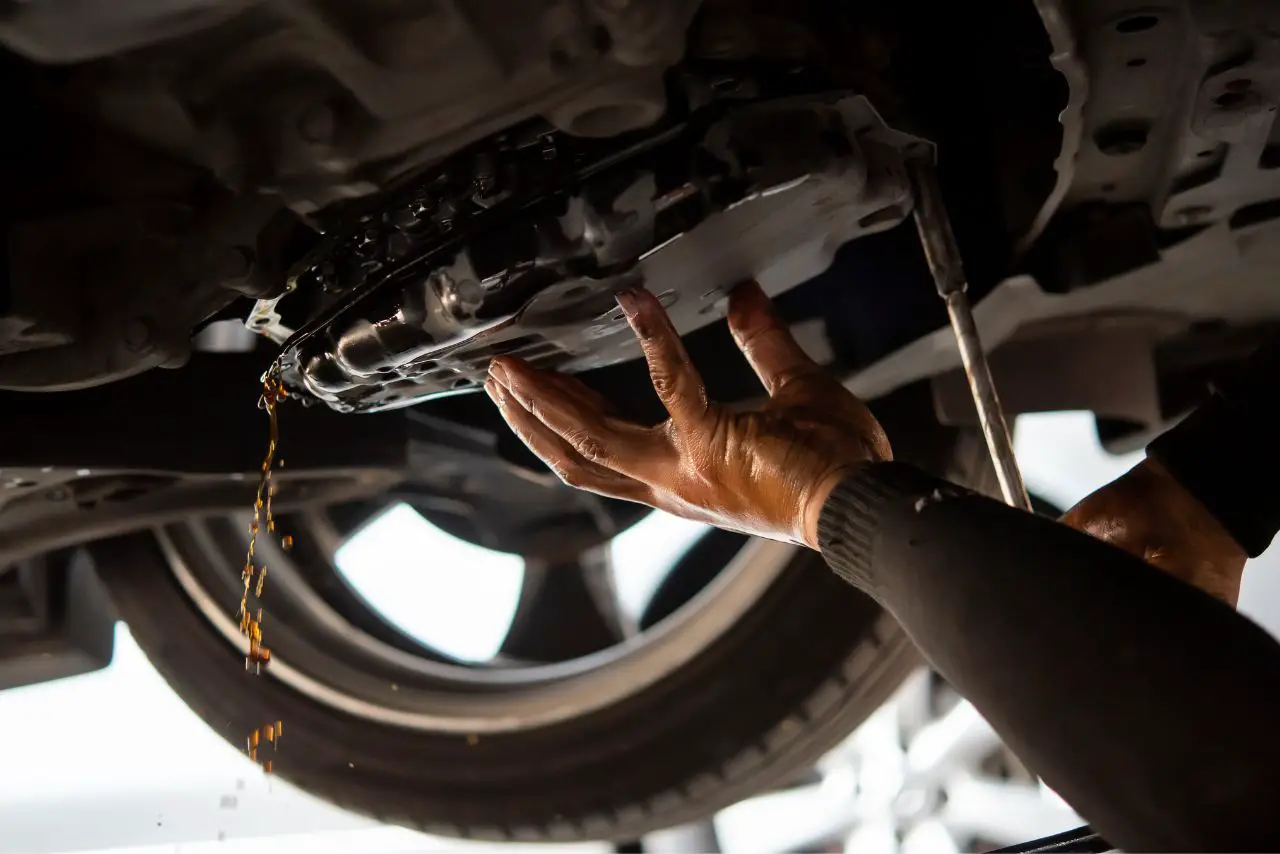Do You Have To Take Off Brake Fluid Cap When Changing Brake Pads? The answer is yes. The brake fluid cap needs to be removed before you start working on your brakes because it will allow air to flow into the brake lines, which will prevent any pressure build-up.
Brake pads are an essential part of your vehicle’s braking system. They are the components that press against the rotor to create friction and slow down or stop your car.
Over time, brake pads wear down and need to be replaced. If you hear a grinding noise when you apply the brakes, it’s a clear sign that your brake pads need to be changed.
In this article, we’ll guide you through the steps for changing your brake pads and explain why it’s necessary to remove the brake fluid cap.
Should You Take Brake Fluid Cap Off when Changing Brake Pads?
It’s crucial to remove the brake fluid cap before changing brake pads to avoid any potential hydraulic pressure build-up. This is a safety precaution that should not be overlooked.
Before you begin, make sure that you have all the proper tools, including a jack, jack stands, a lug wrench, and a socket set.
It’s also important to know what type of brake pads your vehicle requires, as there are different types available.
Proper brake maintenance is essential for ensuring that your vehicle is safe to drive. Regularly checking and changing your brake pads can prevent costly repairs and accidents.
While some people choose to do their own brake pad replacement, it’s important to note that professional mechanics have the experience and knowledge to do the job correctly.
How Brake Pads Work?
Understanding how brake pads function can be crucial in ensuring the safety and reliability of your vehicle.
Brake pads are an integral part of the braking system, responsible for creating the necessary friction to slow down or stop your vehicle.
Here are some key points to consider when it comes to brake pad design and function:
- Friction material: Brake pads are made up of a combination of materials, including metal shavings and organic compounds. This friction material is responsible for creating the necessary friction to slow down your vehicle.
- Wear indicators: Most brake pads are equipped with wear indicators that alert you when they need to be replaced. These are small metal tabs that begin to make contact with the rotor when the brake pad wears down to a certain level.
- Braking systems: There are two main types of braking systems: disc brakes and drum brakes. Disc brakes use brake pads to create friction against a rotor, while drum brakes use shoes that press against the inside of a drum.
- Heat dissipation: The friction created by the brake pads generates a significant amount of heat. To prevent the brakes from overheating and losing their effectiveness, brake pads are designed to dissipate heat quickly.
Understanding how brake pads work is essential for maintaining the safety and reliability of your vehicle.
By keeping an eye on your brake pads’ wear and ensuring they are functioning correctly, you can prevent accidents and costly repairs down the line.
When to Replace Your Brake Pads?
Knowing when to replace your brake pads is crucial for keeping you safe on the road.
As a responsible driver, you should be aware of the signs of worn out brake pads and take the necessary steps to replace them before it’s too late. Ignoring the warning signs can lead to serious accidents and costly repairs.
To help you determine when it’s time to replace your brake pads, here are some common signs to look out for:
| Sign of Worn Out Brake Pads |
|---|
| Squeaking or squealing noise while braking |
| Reduced brake responsiveness |
| Vibrations when applying brakes |
| Longer stopping distance |
| Brake warning light on dashboard |
Regular brake maintenance is important to ensure your brake pads are in good condition.
It’s recommended to have your brakes inspected every 12,000 miles or as per your vehicle manufacturer’s recommendation.
Can You Open Brake Fluid Reservoir When Hot?
If you’re wondering whether it’s safe to pop open the brake fluid reservoir on a hot day, the answer is no. Brake fluid temperature plays a crucial role in the smooth functioning of your vehicle’s braking system.
When the brake fluid gets heated up, it expands, which can lead to a drop in brake pressure.
This can cause a decrease in braking performance, which can be dangerous while driving. Therefore, it’s essential to follow safety precautions when dealing with brake fluid.
Here are some safety precautions to keep in mind while working with brake fluid:
- Always wear gloves and eye protection while handling brake fluid to prevent any skin or eye irritation.
- Use a brake fluid tester to check the brake fluid boiling point and ensure that it’s within the recommended range.
- Avoid contaminating the brake fluid with any other substances, such as oil or grease, as this can affect the fluid’s performance and potentially cause damage to the braking system.
By following these safety precautions, you can ensure that your vehicle’s braking system remains in good condition and functions smoothly.
Steps for Changing Your Brake Pads
- To replace your brake pads, start by loosening the lug nuts on the wheel using a lug wrench.
- Once the wheel is off, locate the brake caliper and remove the bolts that hold it in place.
- Gently pry the caliper away from the rotor and slide out the old brake pads.
- Inspect the brake pads for wear indicators and thickness. If the pads are less than 1/8 inch thick, they need to be replaced.
- Before installing the new brake pads, clean the brake caliper and rotor with brake cleaner.
- Apply a small amount of brake grease to the back of the new pads and insert them into the caliper.
- Reinstall the caliper and bolts, and tighten them to the manufacturer’s specifications.
- Finally, replace the wheel and lug nuts, and tighten them in a star pattern.
Remember to pump the brake pedal a few times to restore normal brake pressure. Common brake pad problems include squeaking, grinding, and uneven wear.
If you experience any of these issues, it may be time to replace your brake pads.
Checking the Brake Fluid Level
First, check your brake fluid level by locating the reservoir and removing its cap with a rag. You need to ensure that the brake fluid is at the right level before changing your brake pads.
Brake fluid is a vital component in your braking system, and it should be checked regularly to prevent brake failure.
Here are three things to keep in mind when checking your brake fluid level:
- Brake fluid contamination can occur when moisture gets into the brake system. This can cause corrosion and decrease the effectiveness of the brake fluid.
- There are different types of brake fluid, and they’re not interchangeable. Using the wrong type of brake fluid can cause brake failure. Make sure to use the correct type of brake fluid specified in your vehicle’s owner’s manual.
- Brake fluid maintenance includes checking the level regularly and replacing the fluid every two years or as recommended by the manufacturer. Brake fluid pressure should also be checked to ensure that the brakes are functioning correctly. Brake fluid flushing is necessary when the fluid becomes contaminated or when the brake system is opened for repairs.
By taking the time to check your brake fluid level, you can prevent brake failure and ensure that your brakes are functioning correctly.
Removing the Brake Fluid Cap
Before proceeding, make sure you’ve got a rag handy to remove the brake fluid cap with ease. The brake fluid cap is located on the top of the brake master cylinder.
It is essential to remove this cap to change your brake pads because it allows you to release the pressure in the brake system.
Failure to remove the brake fluid cap before changing your brake pads can result in fluid contamination, which can lead to brake failure.
Removing the brake fluid cap is a relatively simple process, but it is important to observe safety precautions.
First, ensure that the engine is turned off and the brake pedal is not depressed. Secondly, wear gloves to protect your hands from any brake fluid spills.
Thirdly, use a clean rag to remove the brake fluid cap. After removing the cap, put it in a safe place where it won’t get dirty or lost.
Finally, ensure that you dispose of the old brake fluid properly. Remember, brake fluid is highly toxic and should not be poured down the drain.
Pushing the Caliper Piston Back In
Now that the brake fluid cap is off, you can use a C-clamp and a piece of cardboard to push the caliper piston back into the caliper.
This is an important step in the process of changing brake pads, as it allows enough space for the new pads to be installed.
However, pushing the piston back in can be tricky if you don’t know what you’re doing. Here are some tips for making this step easier:
- Caliper maintenance: Before attempting to push the caliper piston back in, make sure the caliper itself is in good condition. Check for any signs of damage or leaks, and clean the caliper thoroughly before proceeding.
- Piston lubrication: Apply a small amount of brake fluid or silicone lubricant to the piston before pushing it back in. This will help prevent damage to the piston and ensure smooth operation.
- Brake pad bedding: After installing the new brake pads, it’s important to properly bed them in. This involves gradually increasing the braking force over a period of time, which helps to transfer a layer of material from the pads to the rotors for improved performance.
- Brake bleeding: If you notice any air bubbles in the brake fluid while pushing the piston back in, it may be necessary to bleed the brakes to remove the air and ensure proper braking performance.
By following these tips, you can ensure that pushing the caliper piston back in is a smooth and easy process, and that your new brake pads will perform at their best.
Refilling the Brake Fluid
Once the caliper piston’s pushed back in and the brake pads are installed, it’s time to refill the brake fluid. Before doing so, make sure to clean the brake fluid reservoir and cap to prevent any contamination.
It’s important to use the correct type of brake fluid for your vehicle, as different types have different boiling points and can affect the performance of your brakes.
Check your vehicle’s owner manual to find out which brake fluid’s recommended.
When refilling the brake fluid, make sure to pour it slowly and avoid spilling any on the engine or other components. It’s also important to periodically check the brake fluid level and test its quality.
Over time, brake fluid can become contaminated with moisture, which can cause corrosion and reduce its effectiveness.
If you notice any changes in the color or consistency of the brake fluid, or if it has been more than two years since the last brake fluid replacement, it may be time to bleed the brakes and replace the fluid.
Do You Have to Drain Brake Fluid when Changing Brakes?
When changing your brakes, it’s not always necessary to drain the brake fluid. However, it is important to take some precautions to ensure brake fluid safety and avoid brake fluid contamination.
Before beginning any brake work, make sure to read the instructions for your specific vehicle and brake system.
One important thing to consider is the type of brake fluid in your system. Different brake fluids have different properties and can react differently with brake components.
It’s important to use the correct type of brake fluid when refilling your system.
To emphasize the importance of brake fluid safety and contamination, consider the following table:
| Brake Fluid Safety | Brake Fluid Contamination |
|---|---|
| Always wear gloves and eye protection when working with brake fluid | Brake fluid can become contaminated with moisture, dirt, and debris |
| Do not allow brake fluid to come into contact with painted surfaces | Contaminated brake fluid can cause damage to brake components |
| Dispose of used brake fluid properly according to regulations in your area | Regular brake fluid testing can help prevent contamination and ensure proper brake system function |
By following these guidelines and taking proper precautions, you can safely change your brake pads without draining the brake fluid and maintain the integrity of your brake system.
Frequently Asked Questions
Can you reuse old brake fluid when changing brake pads?
Do not reuse old brake fluid when changing brake pads. Brake fluid has a shelf life and can become contaminated, causing damage to your brake system.
Properly dispose of old fluid and test new fluid for color change and contamination.
Is it necessary to replace the entire brake system when changing brake pads?
When changing brake pads, it is not necessary to replace the entire brake system. However, proper brake system maintenance is crucial to ensure optimal performance. Consider factors like brake pad material selection, brake pad wear indicators, the brake pad bedding process, and brake pad noise reduction.
Can you use any type of brake pads with any type of brake rotor?
To ensure optimal performance, it’s essential to consider brake pad compatibility with rotor material.
Different pads offer varying lifespans and noise levels, and proper installation is critical. Always consult your vehicle’s manual and use recommended parts.
Can you change brake pads without removing the wheels?
Changing brake pads without removing wheels can be a time-saver, but it may also have drawbacks.
It can shorten pad lifespan and make it difficult to inspect other components.
Safety precautions, proper tools, and following best practices are essential for success.
Can you change brake pads without using a brake pad spreader tool?
Yes, there are alternative methods to using a brake pad spreader tool when changing brake pads.
DIY options include using a C-clamp or screwdriver to compress the piston. Professional solutions may involve using a hydraulic press.
These cost-effective and time-saving techniques can be effective.
Conclusion and Final Thoughts 💭
So, Do You Have To Take Off Brake Fluid Cap When Changing Brake Pads? Yes, you do. It’s important to remove the brake fluid cap to prevent pressure buildup in the brake system and to allow for the caliper piston to be pushed back in.
When changing your brake pads, it’s important to follow proper steps to ensure your safety and the effectiveness of your brakes. These steps include removing the brake fluid cap, pushing the caliper piston back in, refilling the brake fluid, and testing your brakes before driving.
By following these steps, you can ensure that your brakes are working properly and that you can stop safely on the road. Always prioritize safety when working on your vehicle.





